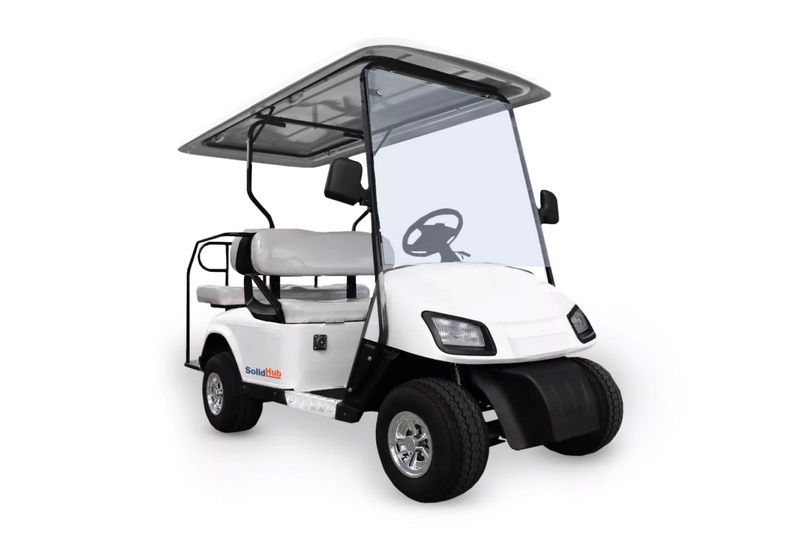Content Menu
● Understanding Electric Golf Carts
>> Battery Types and Their Impact
● How Many Rounds Can You Play?
● Factors Influencing Battery Life During Rounds
>> Course Conditions
>> Battery Maintenance
● Benefits of Using Electric Golf Carts
● Conclusion
● FAQs
>> 1. How far can an electric golf cart travel on a full charge?
>> 2. How long do electric golf cart batteries last?
>> 3. Can I use an electric golf cart on hilly courses?
>> 4. What maintenance do electric golf carts require?
>> 5. Are electric golf carts better than gas-powered ones?
Golf is a sport that combines skill, strategy, and a love for the outdoors. As the game has evolved, so too have the tools we use to play it. One such innovation is the electric golf cart, which has become a staple on courses around the world. This article explores how many rounds of golf can be played in an electric cart, the factors affecting this number, and the benefits of using electric carts.

Understanding Electric Golf Carts
Electric golf carts are powered by rechargeable batteries, typically either 36-volt or 48-volt systems. They are known for their quiet operation, low maintenance costs, and environmental benefits compared to gas-powered carts. The average electric golf cart can travel between 20 to 40 miles on a single charge, depending on various factors such as battery type and terrain.
Battery Types and Their Impact
1. Lead-Acid Batteries: These are the traditional battery type used in many electric carts. They generally last about 3 to 5 years and can provide sufficient power for approximately 18 holes of golf under normal conditions.
2. Lithium-Ion Batteries: More modern and efficient, lithium-ion batteries can last up to 10 years and offer better performance, including longer ranges and faster charging times.
How Many Rounds Can You Play?
The number of rounds you can play on a single charge of an electric golf cart depends on several factors:
- Battery Capacity: The higher the voltage and amp-hour rating of the batteries, the more energy they can store.
- Terrain: Hilly courses require more power to navigate than flat ones. Electric carts may consume more battery life when climbing steep inclines.
- Weight Load: The weight of the passengers and equipment affects how much energy is used during a round.
- Driving Style: Frequent acceleration and high speeds will drain the battery faster than a more conservative driving style.
On average, a fully charged electric cart can comfortably complete one full round (18 holes) of golf. However, with optimal conditions—such as flat terrain, minimal weight, and efficient driving—many users report being able to complete two rounds (36 holes) before needing to recharge.

Factors Influencing Battery Life During Rounds
Course Conditions
The condition of the golf course plays a significant role in how many rounds you can complete. For instance:
- Flat Courses: Easier on the battery, allowing for longer usage.
- Hilly Courses: Require more energy for climbs, reducing overall range.
Battery Maintenance
Proper maintenance of your golf cart's batteries is crucial for maximizing their lifespan and performance:
- Regular Charging: Always charge your batteries after use to prevent deep discharges.
- Water Levels: For lead-acid batteries, ensure water levels are adequate to prevent damage.
- Clean Connections: Regularly check and clean battery terminals to ensure good electrical connections.
Benefits of Using Electric Golf Carts
Electric golf carts offer numerous advantages over traditional gas-powered models:
- Environmental Impact: They produce zero emissions, making them a greener choice for eco-conscious golfers.
- Operational Costs: Lower fuel costs (electricity vs. gasoline) and minimal maintenance requirements lead to significant savings over time.
- Noise Reduction: Electric carts operate quietly, enhancing the overall golfing experience without disturbing wildlife or other players.
Conclusion
In conclusion, an electric golf cart is not only a convenient mode of transportation on the course but also an environmentally friendly option that can enhance your golfing experience. Typically, you can expect to complete one full round (18 holes) on a single charge under standard conditions. With proper care and optimal conditions, some players may even achieve two rounds before recharging becomes necessary.

FAQs
1. How far can an electric golf cart travel on a full charge?
Electric golf carts typically travel between 20 to 40 miles on a full charge depending on battery type and course conditions.
2. How long do electric golf cart batteries last?
Lead-acid batteries last about 3 to 5 years while lithium-ion batteries can last up to 10 years with proper care.
3. Can I use an electric golf cart on hilly courses?
Yes, modern electric golf carts are designed to handle hilly terrains effectively; however, they may consume more battery power in such conditions.
4. What maintenance do electric golf carts require?
Regular charging after use, checking water levels (for lead-acid batteries), cleaning terminals, and periodic inspections are essential for maintaining electric carts.
5. Are electric golf carts better than gas-powered ones?
Electric carts are generally considered better due to their lower operational costs, zero emissions, quieter operation, and reduced maintenance needs.




















































